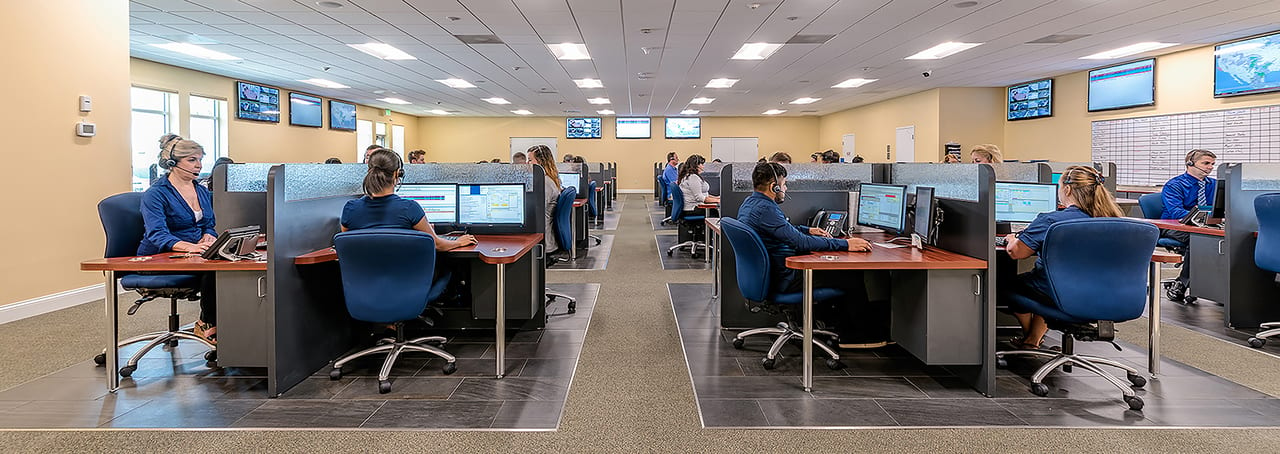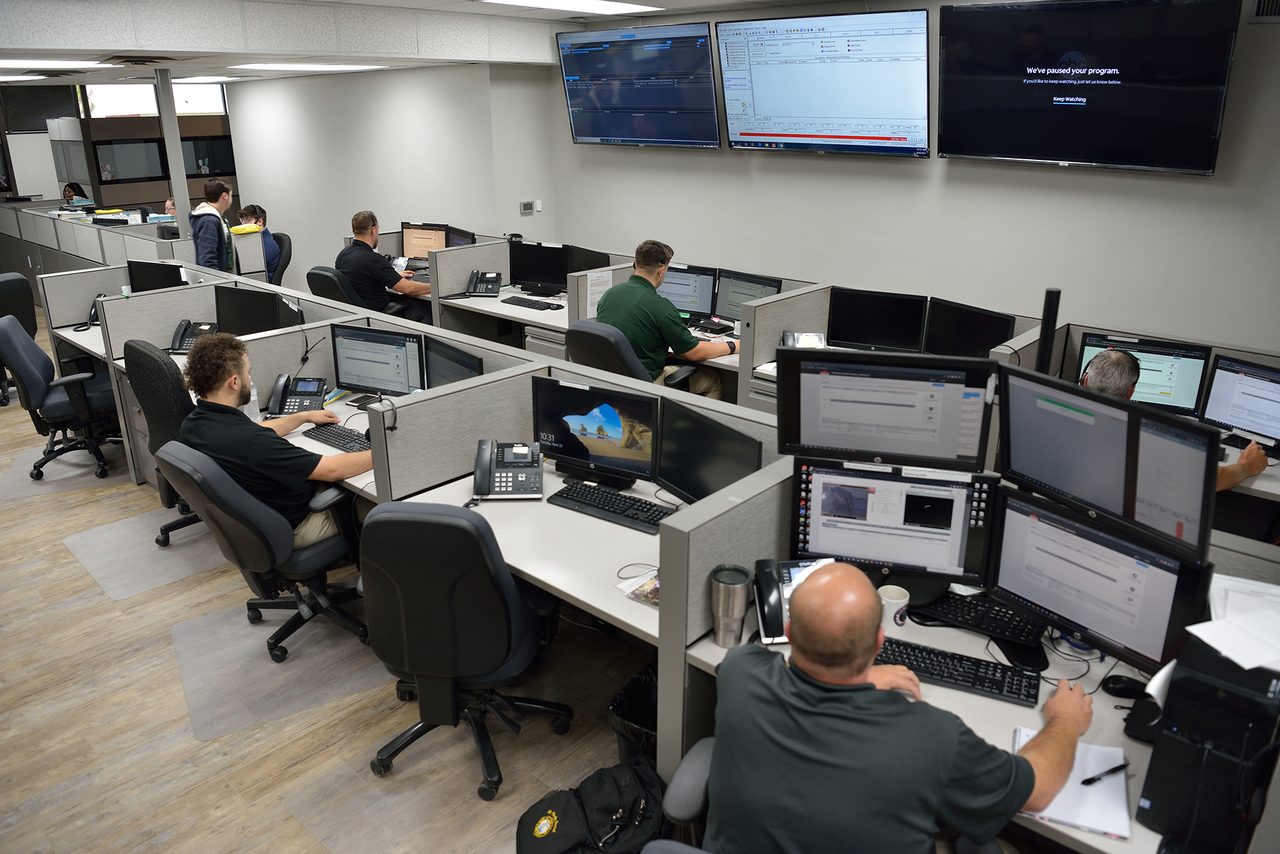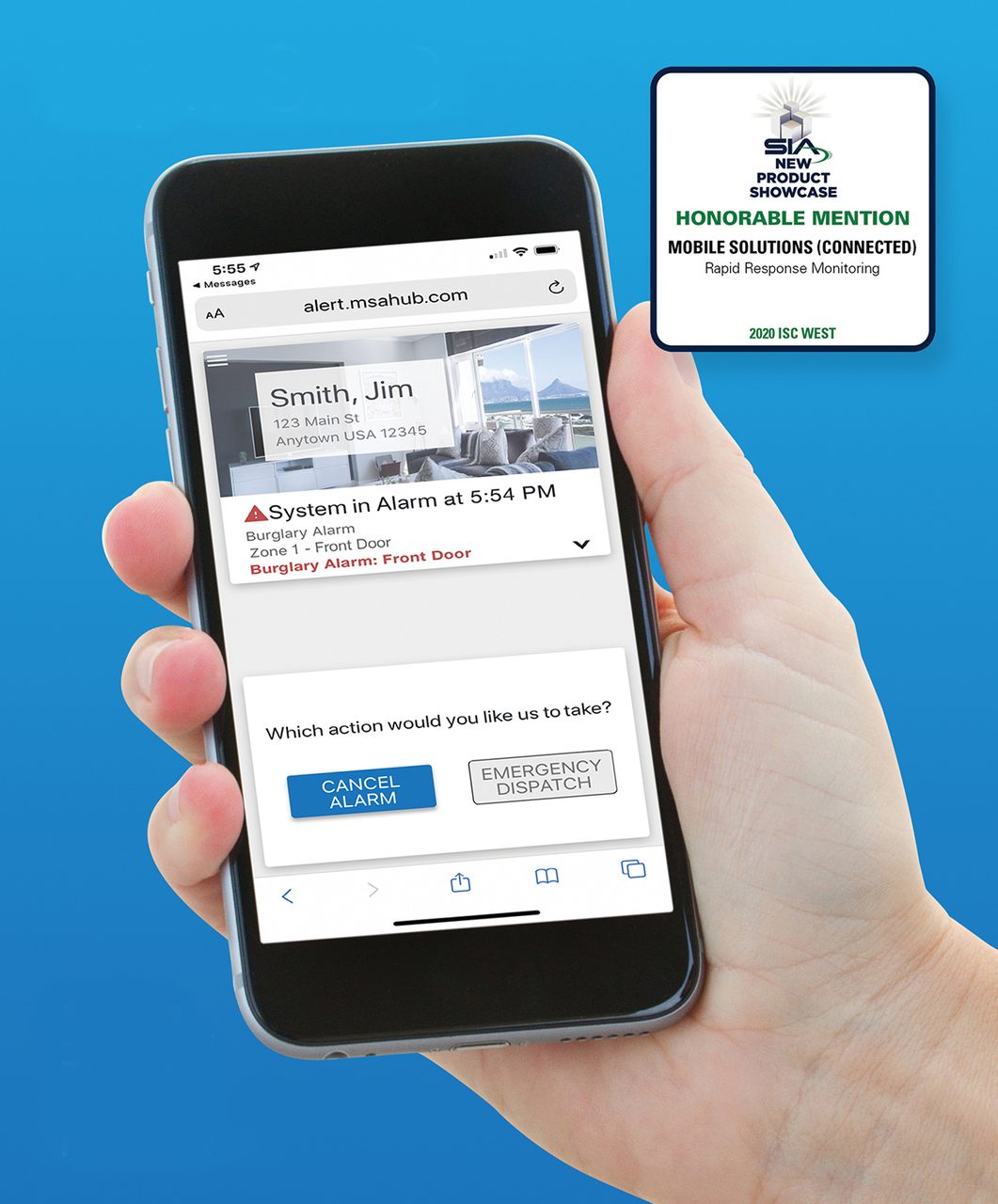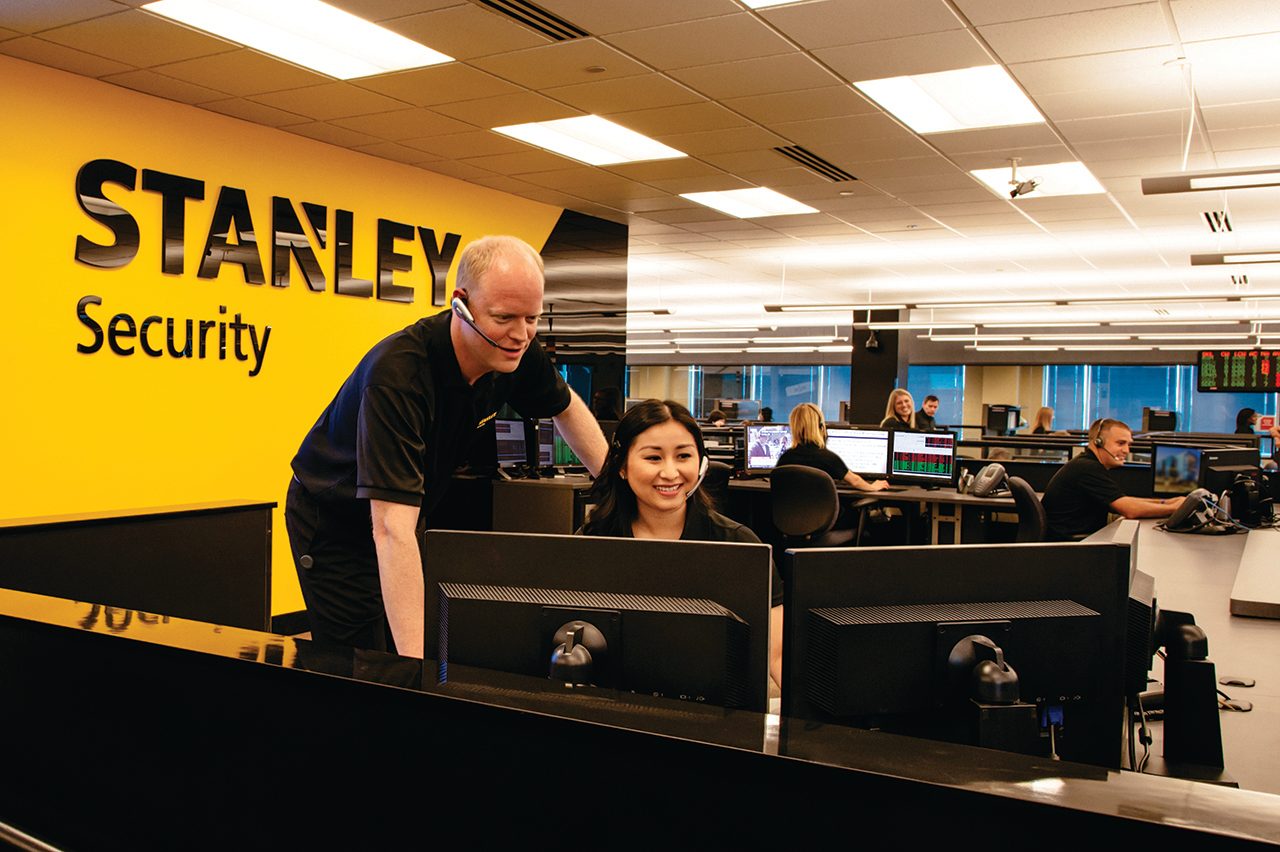// Security Monitoring

All American Monitoring got its redundant monitoring station ready to go this year.
IMAGE COURTESY OF ALL AMERICAN MONITORING
Wholesale Central Stations
Continue to Innovate
ASAP-to-PSAP is on the rise. Video monitoring gains greater focus. Apps yield big benefits.
By Joan Engebretson, SDM Contributing Writer
What’s new in wholesale central station monitoring? We checked in with several third-party central stations to ask about this.
Some common threads were an increased focus on video monitoring, increased use of apps to streamline interactions between end users and central stations operators, increased use of ASAP-to-PSAP, and more.
Here’s what several of the wholesale central stations told us.
Acadian Monitoring Services
To focus on its goal of being recognized as one of the premiere video monitoring centers in the industry, Acadian Monitoring Services has ceased providing basic traditional monitoring that doesn’t encompass any video component.
This allows an intense concentration on video monitoring in all its forms and presents a unique opportunity for security dealers and integrators to partner with a monitoring center dedicated to providing world-class video monitoring services. Acadian’s current video offerings are constantly being enhanced to incorporate the latest advanced analytics and AI technologies.
Acadian Monitoring Services only monitors accounts that have a video component, enabling the company to gain video expertise.
IMAGE COURTESY OF ACADIAN MONITORING SERVICES

All American Monitoring
In the past year All American Monitoring has integrated with Alarm.com, Security Trax, WorkHorse, and MKMS billing. Also this past year, UL’s new requirement went into effect, which said in order to stay UL compliant you must have a redundant monitoring station; so this year involved a lot of work to get AAM’s redundant facility ready to go.
One of All American Monitoring’s newer services is a specialized answering service for the company’s dealers. It is completely customizable to meet the unique needs of each company and is tailored for the security industry.
Over the past year, AAM’s main focus has been the upcoming 3G/4G sunset. The company has been preparing its dealers by notifying them about which accounts will need upgraded radios and by offering a rebate program. For every 3G/4G radio that the dealer replaces with All American Monitoring’s M2M LTE radio, the dealer will receive a $25 rebate.
Central Stations Amid COVID-19
When the COVID-19 pandemic was declared a national emergency in March 2020, Underwriters Laboratories (UL) allowed central station operators to work from home following certain guidelines, an option that didn’t exist previously. Central stations that promptly availed themselves of that option included American Two-Way, EMERgency 24, and others.
Because COVID-19 is still considered a national emergency, the guidelines that UL established last year for central station operators working at home remain in effect, explains Steve Mayer, vice president of operations and administration for EMERgency 24.
And even when the COVID-19 emergency ends, central station operators will continue to have the option of working at home, provided that they conform to stricter UL guidelines that will go into effect at that time, Mayer notes. UL adopted that provision last summer, he noted.
Among the stricter long-term guidelines for operators working from home: having a primary and backup network connection and having an uninterruptible power supply that, in the event of an outage, will provide power long enough for alarms in the operator’s queue to be transferred to another operator.
At the peak of the COVID-19 pandemic, just over 75 percent of EMERgency 24 operators were working from home. That number now has dropped to around 55 to 60 percent.
The company doesn’t allow newly hired operators to work from home until they have demonstrated their proficiency and achieved a certain productivity level, Mayer notes.
Not every central station allows operators to work from home, though. For example, rather than sending operators home to work, Rapid Response required operators to come to work at the central station, protecting them through what Spencer Moore, vice president of sales and marketing for Rapid Response, calls “ultra-hygienic facilities including 24/7 cleaning staff, advanced HVAC filtration, and touch-free restroom technologies.”
The company upgraded to Level IV UV HVAC filtration systems and added infrared temperature cameras, four-hour employee temperature checks, UV room sterilizers, UV sterilizing wands and boxes, social distancing of staff members, and focusing the 24/7 cleaning staff to sanitizing every workspace at the end of shifts. Additionally, each employee was provided with a touch-free thermometer to use at home.
The company also initiated daily company-wide communication on the status of COVID-19 in the local areas where the company’s central stations are located, along with any needed changes in protocols, workspaces, or policies.
//
To reduce false alarms, improve notification, and ultimately customer satisfaction, COPS will be rolling out two services to its dealer base in the near future.
The first, called MYALARM.CHAT, sends an immediate SMS/text message to designated parties associated with the alarm with a link to a secure chat room where they can exchange information and make more informed decisions about their security. Then, through the app, users will have the ability to reduce false alarms by electronically cancelling alarms or improve response time by requesting immediate dispatch.
In addition to launching MYALARM.CHAT, the company also plans to increase the availability of SMS notifications to all dealers for all signal types so they can deliver notification to their customers 24 hours a day in the way they prefer.
The MyAlarmChat app from COPS Monitoring sends an immediate SMS/text message to designated parties associated with the alarm with a link to a secure chat room where they can exchange information.
IMAGE COURTESY OF COPS MONITORING

COPS Monitoring
Customers frequently ignore or reject telephone calls from toll-free numbers, especially if they don’t immediately recognize the caller. Unanswered calls can increase the number of false dispatches and complicate alarm notifications. On the other hand, some studies suggest that 90 percent of American adults view text messages within three seconds.
Dynamark Monitoring
The ability to cancel or verify alarms through text message, coupled with the ability to group chat with contacts, has been one of the most transformative changes in monitoring in a long time, Dynamark Monitoring notes. With phone answer rates declining sharply, the industry has experienced an uptick in false alarms. Dynamark created the Instant Connect app to make it easier for customers to be notified of false alarms, chat with contacts, and cancel the alarm right from their phone with no need for another app.
Customer usage rates have been very high and Dynamark has seen a 42 percent decrease in false alarms as a result since launch. This is becoming must-have technology, and with lower false alarm rates, the company anticipates lower attrition as a result.
In 2021 Dynamark launched InSite, a free cloud software platform to help dealers manage their business from anywhere. The platform was designed in-house and makes it possible for dealers to access everything customer-related from a laptop or phone anywhere in the world.
EMERgency 24
Despite the pandemic, EMERgency 24 continued to have growth, and the company attributes that to the way it supports its alarm contractors and continually develops new services so contractors can generate more revenue each month.
The company’s customer service department doesn’t have specialists — whoever picks up the next call is fully trained and prepared to help the customer without transferring to someone else.
The company says these customer service differentiators are linked directly to its proprietary software. Customer service representatives have intimate knowledge of the company’s software, and the company can add new services at any time it chooses.
Recently, EMERgency 24 solidified its strategic partnership with BluePoint Alert Solutions, which is an active shooter service. The company has also chosen the CHeKT platform, which it sees as a flexible and robust video platform.
EMERgency 24 highlights its dealer-friendly contract as another differentiator. Before any alarm contractor chooses a wholesale central station, EMERgency 24 advises the contractor to compare the agreements to see which one best protects the contractor’s accounts, which are the contractor’s greatest asset.
Netwatch North America’s continued success is largely attributed to three primary attributes: First, the company’s expertly trained intervention specialists have the specialized skillsets required to detect, analyze, and address potential threats in real time, allowing for an instant response.
Second, Netwatch North America maintains best-in-class PVM communication monitoring centers with geo-diversity to maintain continuous vigilance of customers’ assets with total redundancy.
And third, the company specializes in business and critical infrastructure operations with a specific focus on utilities, construction, quarries and mines, warehousing and logistics, car dealerships, and cannabis. Knowing the distinct nuances of these specialized industries enables Netwatch PVM to support critical business operations and compliance challenges.
Netwatch North America Proactive Video Monitoring (PVM) provides live situational awareness.
IMAGE COURTESY OF NETWATCH

Netwatch North America
Netwatch North America Proactive Video Monitoring (PVM) provides live situational awareness through virtual on-premises video to detect and prevent incidents. This approach to risk mitigation is ideal for mission-critical physical infrastructure that requires specialized support to reduce liabilities and maintain compliance.
ASAP-to-PSAP Benefits
ASAP-to-PSAP stands for automated secure alarm protocol (ASAP) to public safety answering point (PSAP), the facilities responsible for answering calls to 911. The ASAP-to-PSAP program is designed to enable central stations to send alarm information to the PSAP through a secure data feed, eliminating the need for a phone conversation between the central station and the PSAP.
PSAPs must make certain upgrades to their equipment to support ASAP-to-PSAP capability and more and more of them are making that investment.
//
Rapid Response Monitoring
Rapid Response Monitoring just completed its 92nd PSAP integration with ASAP and has more in the pipeline. The company recently transitioned to the new ASAP-to-PSAP infrastructure, which The Monitoring Association (TMA) put into place in the second quarter of 2021. This new infrastructure is more robust and secure than the previous implementation, Rapid Response says. ASAP-to-PSAP allows the company to seamlessly dispatch authorities electronically and not only saves time but also is always 100 percent accurate because of the pre-authentication of addresses. It also allows operators to quickly cancel alarms when necessary.
Rapid also continues to improve and roll out more features to its rapidSMS application. This SMS and web-based application allows subscribers to quickly interact with the monitoring center in the event of an alarm. The company has 800,000+ subscribers using rapidSMS today and has seen consistent results of reducing dispatches in the 40 percent range.
The central station’s UL-listed Honeywell CLSS direct connection receivers are now online and available to receive Honeywell IFOM signals directly from the new CLSS gateways. This connection allows fire panels to send 10 times the amount of rich data than they could under the previous contact ID scheme, directly to the monitoring center in less than a second.
The rapidSMS app lets customers quickly interact with the central station and has reduced dispatches by 40 percent.
IMAGE COURTESY OF RAPID RESPONSE MONITORING

STANLEY Security Wholesale Monitoring
STANLEY Security focuses on offering global resources with a local touch. STANLEY Security Wholesale Monitoring focuses on four dealer touch points: account management, service, monitoring, and billing.
The company continues to expand its use of ASAP-to-PSAP in jurisdictions that are set up with that capability. This has made dispatching quicker and response times have seen the impact. The company is also in the final beta stages of implementing interactive video monitoring using Immix. STANLEY hopes to release this capability to its dealer base in the first quarter of 2022. SDM
STANLEY Security Wholesale Monitoring has expanded its use of ASAP-to-PSAP in jurisdictions that are set up with that capability.
IMAGE COURTESY OF STANLEY SECURITY WHOLESALE MONITORING

